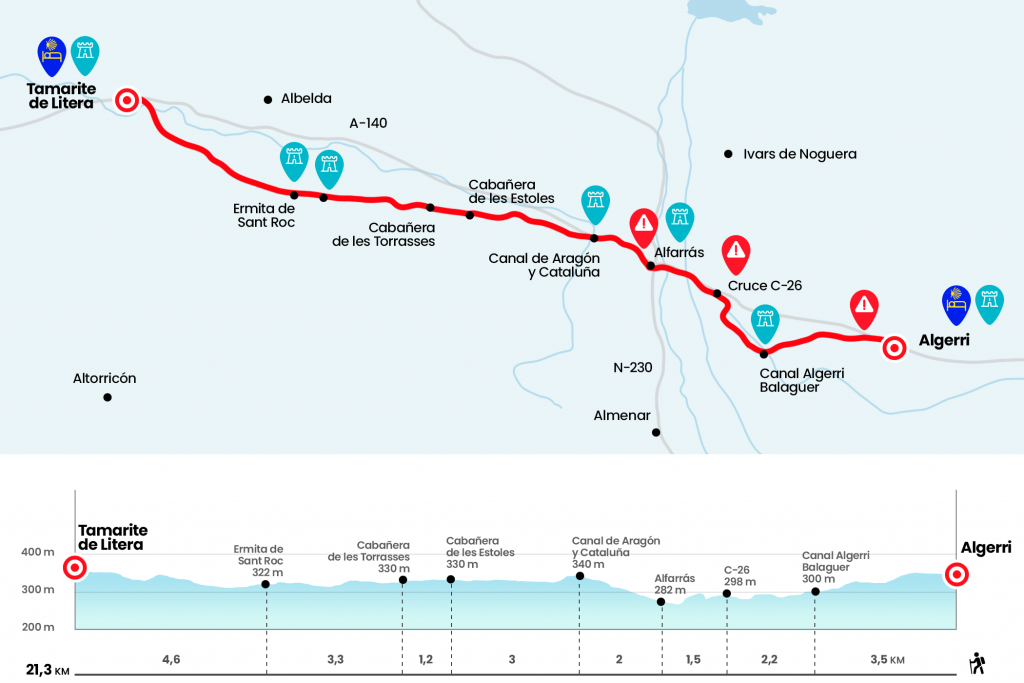Article translated by an automatic translation system. Press here for further information.
Algerri to Tamarite de Litera Stage
La Litera land takes the traveler for 14 long km to Tamarite
Information about the stage 6: Algerri to Tamarite de Litera Stage

Enlarge map
Points of interest in the stage 6: Algerri to Tamarite de Litera Stage
The route
We leave Algerri on the C-26 road, pass by the bar-gas station and walk the first meters of the stage through the arcén, exit well indicated by the yellow arrows that mark year after year the Amics dels Pelegrins to Santiago – Barcelona. We walked around the asphalt about 600 meters and left the road on the left, boarding through the Camí d’Almenar (as shown in the maps). We advance without loss to the olive groves, seeing the town of Almenar ahead, until crossing section A of the canal Algerri-Balaguer, infrastructure of the 90s that allows to water with the waters of Noguera Ribagorçana an estimated area of 8,000 hectares (Km 3.5).
At this point, two alternatives emerge: to continue with the Generalitat sign or to continue through the section recommended by the Amics dels Pelegrins, marked with yellow arrows and progressing on the right, following the canal course on the service track. After 2.2 kilometers past the top picadero, we go to C-26 (Km 5,7) and follow it on the left, reaching the passage of the river Noguera Ribagorçana, which establishes the boundary between the counties of La Noguera and the Segriá. We cross the river and meet in Alfarras, the last town of Catalonia on the Camino and the only intermediate population of the stage. We move on to the entrance on the Pinyana Canal, the oldest irrigation of Catalonia, as it is the extension of the first Almenar acequia built in the middle of the 12th century. Alfarras is a large population with all services and remember that the only revival of the stage (Km 7.2).
The urban route has no loss, Alfarras crosses front by Balmes Avenue, coinciding with the road. The roundabout of the N-230 is also drawn from the front to resume the journey through the arcén of the C-26. After a kilometer and a half in a slight climb we reached the elevated canal of Aragon and Catalonia, where this Jacobean itinerary fired to Lleida and Catalonia to welcome Huesca and Aragon. We also say goodbye to the Segria to discover the region of the Litera (Km 9.2).
At 200 meters we left the road on the left at the junction of Almacelles and then entered the road that was born to the right, next to a house with pool. See, because at 300 meters we leave the way, when it draws a curve to the left, and we go in front of the grass following a few rounds. It helps us to guide an arrow painted by the trunk of a fruit tree. In a few hundred meters, always facing, we enter another path, well-marked, which advances 50 meters from the A-140 road. The aroma of pigs from previous days returns to our noses and the runway runs in front without apparent complications apart from some rafts, farms and cottages known in this area as Torres.
We cross a paved road next to Torre del Rito which is none other than the perpendicular cabanera of Les Estoles (Km 12,2), whose name is not marked. A quarter of an hour later we do the same with the cabañera of Les Torrasses (Km 13.4) and half a kilometer later we turn right and then left, regaining direction. Care because you don't have to continue down the road marked for mushing training. The track, in some already paved sections, progresses without further course changes and passes along a raft and the crossing that leads to a millenary sabina albar (Km 15,9). From the front we arrived in less than a kilometer to the hermitage of Sant Roc, baroque and sandstone (Km 16,7).
After the hermitage we continued straight and passed the acequia of the Magdalena (Km 17.2). In the final stretch, endless by the apparent proximity of a Tamarite de Litera fitted between the sandstone walls, there are several slides that make the arrival even more expensive. After the football field and the institute we reached the A-140 and followed it on the right after passing the canal to the entrance of the town. (km
21.3)
The difficulties
Remarks
In images
What to see, what to do
The hostels

¿Do you want to send any photo of "The Camino de Santiago"?
If you have any photos of "El Camino de Santiago" that you want to share with us, you can send them to us and enlarge the photo gallery


Forum: What pilgrims think about the Camino de Santiago
See all